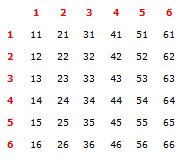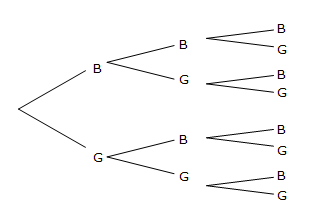Timetable › Forums › Standard › Probability & Relative Frequency › Probability
Tagged: probability
-
AuthorPosts
-
A box contains blue, red and white marbles. Write an algebraic expression for:
a. The probability of a blue marble.
b. The probability of a blue or white marble.
c. the Probability for a not blue marble.total amount of marbles = b + r + w
a. P(B) = $$\frac{b}{b+r+w}$$
b. P(B or W) = $$\frac{b+w}{b+r+w}$$
c. P(not B) = $$\frac{r+w}{b+r+w}$$
In a game of football, Team A has a 41% chance of beating Team B, while team B has a 51% chance of beating Team A.
a. What is the other outcome?
b. What is the probability of this outcome?a. Draw
b. Team A has a 41% chance of winning
P(Win) = 41%
Team B has a 51% chance of winning which means Team A has a 51% chance of losing
P(Lose) = 51%
the probability of a draw will be 100% – 41% – 51%
= 8%∴ P(Draw) = 8%
Tracey is twice as likely to solve a maths problem as Terry is. If Tracey has a 25% chance of solving the problem. What are the chances of both Terry and Tracey solving the problem?
If Tracey is twice as likely as Terry, that means the Terry is half of Tracey.
Half of 25% is 12.5%
converting these to decimals P(Tracey Right) = 0.25
P(Terry Right) = 0.125
P(both are right) = 0.25 × 0.125
= 0.03125 =
3.125% or 1⁄32For a guessing competition, a jar contains 5 red marbles and an unknown number of white marbles. Jason selected a marble at random from the jar, recorded its colour, and then replaced the marble in the jar. He repeated this procedure until he had made 200 draws. His results showed a red marble being selected 17 times. Predict the total number of marbles in the jar.
he got 17/200 red, so that should be the same as 5/x since they would be in the same proportion.
we get this equation: $$\frac{5}{x}=\frac{17}{200}$$
Flip both sides to make it easier
$$\frac{x}{5}=\frac{200}{17}$$
$$x=5\times\frac{200}{17}$$
x = 58.8
so approximately 59 marbles in
At a tropical holiday resort, the probability of rain on any day is 0.8. What is the probability that it will rain on a particular weekend? P(rain on the weekend) = P(RR) + P(R-) + P(-R)
= (0.8 × 0.8) + (0.8 × 0.2) + (0.2 × 0.8)
= 0.96
we must consider all of the possibilities
Rain on both Sat and Sun: R R
Rain on Sat but not Sun: R –
Rain on Sun but not Sat: – RFive cards are numbered 1, 2, 3, 4 and 5. Two cards are selected and placed together to form a 2-digit number.
a. What is the probability of forming the number 43?
b. What is the probability of an even number occurring?
12, 13, 14, 15
21, 23, 24, 25
31, 32, 34, 35
41, 42, 43, 45
51, 52, 53, 54work out all of the possible digits
doing this in an organised table is the most efficient and easy waya. P(43) = 1/20 there are 20 numbers altogether and only one that forms 43 a. P(even) = 8/20
= 2/5
counting the even numbers, there are 8 of them There is a 9 in 10 chance of a bird hatching and surviving in the Nullarbor Plain. From a nest of 3 chicks, find the probability that:
a. All 3 chicks survive.
b. No chicks survive.
c. Exactly 2 chicks will survive.
a. P(SSS) = 9/10 × 9/10 × 9/10
= 729/1000
P(Survive) = 9/10 P(Dead) = 1/10
for them all to survive, there is only one way this can happen SSSb. P(DDD) = 1/10 × 1/10 × 1/10
= 1/1000
for none to survive they all must be dead: DDD c. P(2S, 1D) = P(SSD) + P(SDS) + P(DSS)
= 9/10 × 9/10 × 1/10 + 9/10 × 1/10 × 9/10 + 1/10 × 9/10 × 9/10
= 243/1000
for 2 to survive, must consider all the ways this can happen
SSD where the first 2 survive and the last one dies
SDS where the middle one dies
DSS where the first one diesSteve buys three tickets in a raffle in which there is a total of 20 tickets. There are two prizes. Find the probability that he wins:
a. First prize.
b. First prize only.
c. Both prizes.
d. No prizes.
e. At least one prize.
f. One prize only.a. P(W) = 3/20 He has 3 tickets, so he has 3 chances out of 20 to win first prize b. P(WL) = 3/20 × 17/19 = 51/380 for this to occur, he has to win first prize and then lose the second prize c. P(WW) = 3/20 × 2/19 = 3/190 to win both he must win first and then second, remembering that if he wins first prize, he only has 2 tickets left out of the 19 left to draw d. P(LL) = 17/20 × 16/19 = 68/95 lose both prizes. if he has 3 tickets, that means there is 17 out of 20 he doesn’t have, which would then be 16 out of 19 for the second draw e. P(at least one) = 1 – P(no prize) = 1 – 68/95 = 27/95 to find the probability of at least 1, the easiest way is to find the probability of none. So if we want at least 1 prize, find the probability of no prizes and subtract from 1 f. P(WL) + P(LW) = 3/20 × 17/19 + 17/20 × 3/19 = 51/190 only one prize could mean win first lose second, OR, lose first and win second Tan buys 2 tickets in a 50 ticket raffle. There are two prizes. What is the probability that Tan wins at least 1 prize? 1 – P(no, no) = 1 – 48/50 × 47/49
= 97/1225
P(at least 1 prize) = 1 – P(no prize)
= 1 – P(no, no) = 1 – 48/50 × 47/49 = 97/1225
Remember: P(at least one) = 1 – P(none)
In a raffle 100 tickets are sold and there are two prizes. A woman buys 5 tickets. What is the probability that:
a. she wins neither prize
b. she wins at least one prize?a. P(LL) = 95/100 × 94/99
= 893/990
we need to find the probability that she loses both prizes. since she bought 5 tickets, there are 95 tickets she doesn’t have b. 1 – P(no prizes) = 1 – 893/990
= 97/990
we just found the probability of no prizes so it will be: P(at least 1 prize) = 1 – P(no prizes) Dice

A pair of dice are rolled. What is the probability of:
a. Getting doubles?
b. A 6 appearing on at least one of the dice?a. P(double) = 6/36
= 1/6Doubles include, 11, 22, 33, 44, 55, 66
there are six of them out of a possible 36b. P(at least one 6) = 1 – P(no 6)
= 1 – P(–)
= 1 – 5/6× 5/6
= 11/36or you can count from the table, all the entries that have at least one 6:
16, 26, 36, 46, 56, 66, 61, 62, 63, 64, 65
there are 11 out of a possible 36A dice is biased so that the chance of obtaining a 6 is twice as likely as any other number. Find:
a. the probability of a 6.
b. the probability of an even number
c. the probability of a prime number.a. P(6) = $$\frac27$$ List the sample space to make it easier: 1, 2, 3, 4, 5, 6, 6 a. P(Even) = $$\frac47$$
Even numbers: 2, 4, 6, 6 a. P(Prime) = $$\frac37$$
Prime numbers are: 2, 3, 5 A newly married couple are planning to have three children.
a. Find the sample space of all possible outcomes.
b. Find the probability of having a boy and two girls.
c. In a survey of 400 families with three children, how many of these families would you expect to have a boy and two girls?a. BBB BBG BGB BGG GBB GBG GGB GGG Easiest way to do this is with a tree diagram 
b. P(1B, 2G) = P(BGG) + P(GBG) + P(GGB) = $$\frac{1}{8}+\frac{1}{8}+\frac{1}{8}$$ = $$\frac{3}{8}$$ a boy and 2 girls is not the same as a boy then 2 girls, so we must consider all the ways this can occur c. $$\frac{3}{8}\times400$$ = 150 to find the expected number, you multiply the probability of the result by the number in the survey -
AuthorPosts
- You must be logged in to reply to this topic.



